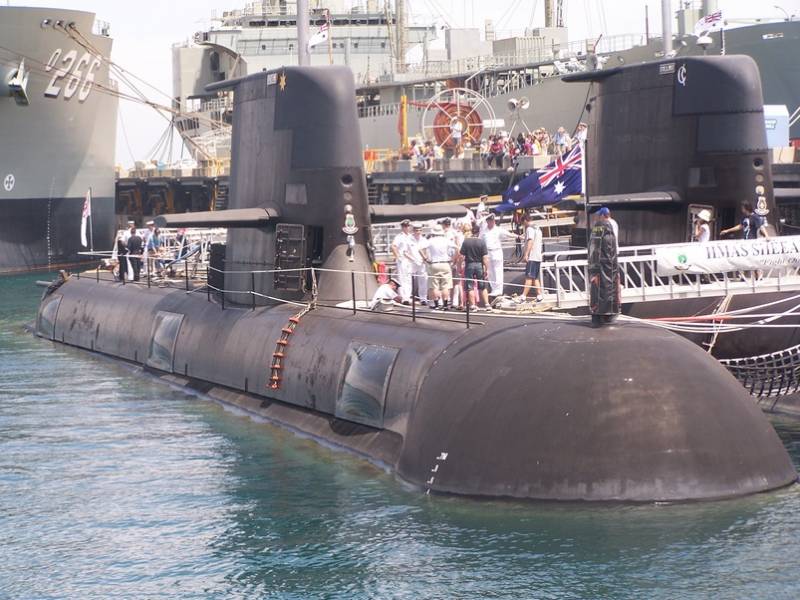Foreign Policy Seeks To Explain Why Australia Needs Nuclear Submarines
Six Collins class submarines are in need of replacement for decommissioning by 2026. Against the backdrop of an outdated and shrinking arsenal of Australia, there is practically nothing to oppose to the rapidly growing the fleet China. According to observers, France was no longer able to meet current needs: since the beginning of cooperation in 2016 between the Australian customer represented by the Ministry of Defense and the French contractor (DCNS, later renamed the "Naval Group"), contradictions arose that reached an insurmountable degree.
The project for the joint construction of 12 Attack class diesel submarines based on the Shortfin Barracuda Block 1A series for the needs of the Australian Navy was initially tested. On the eve of the official signing of the contract with Paris, there was a scandalous leak of data that shed light on the details of the deal. Opposition forces took advantage of the blunder, and the ruling Liberal Party managed to hush up the scandal only with great difficulty. However, later on, new problems arose.
Canberra hoped that the choice of a contractor would guarantee the opening up prospects for access to nuclear technology. And over time, in cooperation with Paris, it will be possible to modernize the fleet by replacing diesel power plants in submarines with nuclear reactors. However, the French, according to Foreign Policy, were in no hurry to share technological secrets: at the same time, realizing the vulnerability of the Australian side's positions, they constantly dragged out the deadlines and tried to revise the terms of the deal - in an advantageous way, of course.
As a result, the total costs for Canberra threatened to increase from the initial 50 to 90 billion Australian dollars (about 56 billion euros in terms of the current exchange rate). And this is already comparable to the cost of nuclear submarines. And this is supposedly why in Australia they drew attention to the possibility of acquiring just such submarines. The argument, I must say, is highly dubious.
Another negative factor that influenced the decision to break with Paris was the deadlock in the implementation of agreements on the share of labor force participation. From the original 90% Australian workforce on the project, France wanted to reduce this figure to 60%. It was about the loss of 2 skilled jobs, a blow to the reputation of the ruling party in Canberra.
It made no sense to regret that in 2016 Australia gave preference to French shipbuilders, rejecting projects from Germany and Japan. Neither Berlin nor Tokyo, for obvious reasons, were able to offer a full-fledged prospect of joining the so-called club of nuclear powers, which Canberra was striving for. But high chances of getting the coveted status opened up in the event of a strategic turn towards Washington and London.
What is Australia hoping to gain - and what will it have to sacrifice? Firstly, this is the notorious and previously severely lame modernization of the fleet, with the prospect of developing a whole range of branches of national industry and science in the framework of technological cooperation with the United States and Great Britain.
American submarines of the Virginia class with the S9G nuclear reactor with a capacity of up to 190 megawatts will definitely give odds to the Chinese diesel submarines, while the US reactors have characteristics comparable to the Russian OK-650 reactor, which are installed on Project 971 submarines (Akula class). The list of British designs includes ballistic missile submarines aboard the Vanguard class and the Astute class.
The implementation of the program for the transfer of Australian submarines to "nuclear drive" also includes the modernization of not only power units, but also other systems: in particular, we are talking about new generations of lithium-ion batteries and the expedient introduction of air-independent fuel cells (AIP).
Second, the Australian authorities expect benefits in terms of budget savings and partial resolution of employment problems. In these areas, Washington and London have promised not to be greedy. In exchange for the place of the next power with a nuclear status, Canberra is ready to provide its defense and industrial infrastructure with all the advantages of a continent close to the Pacific theater of operations, which is strategically important for the United States and England.
How everything will turn out in reality, no one knows. Given the specifics of Washington's foreign policy approaches, drawing Australia into the contour of a potential military confrontation with China is fraught with risks, which the Australian Cabinet of Ministers could not calculate ... or did not want to - under pressure from the United States.

Information